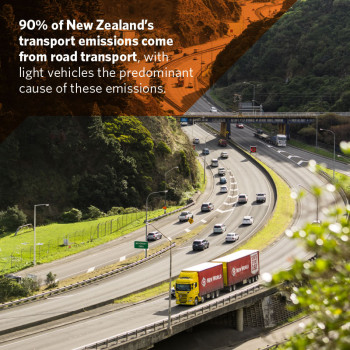 Transport accounts for 18% of New Zealand’s greenhouse gas emissions and has been the fastest growing source of emissions since 1990. Between 1990 and 2015, transport emissions increased by 68% compared with 24% for total gross emissions across the economy. Within transport, road emissions grew by 78%. 90% of New Zealand’s transport emissions come from road transport, with light vehicles (cars and other vehicles under 3.5 tonnes) alone accounting for 67%.[1]
Transport accounts for 18% of New Zealand’s greenhouse gas emissions and has been the fastest growing source of emissions since 1990. Between 1990 and 2015, transport emissions increased by 68% compared with 24% for total gross emissions across the economy. Within transport, road emissions grew by 78%. 90% of New Zealand’s transport emissions come from road transport, with light vehicles (cars and other vehicles under 3.5 tonnes) alone accounting for 67%.[1]
This reflects several factors, with the key ones being:
Supporting a move to cleaner, healthier and more active transport modes like walking and public transport can help address climate change. A small reduction in short vehicle trips potentially generates significant reduction in carbon emissions, because engine pollution controls are not fully effective during cold running[2].
The Queensland Department of Transport and Main Roads found that:
The combined environmental benefits of reducing noise and greenhouse gas emissions, and improving air quality, equates to around 5.9 cents per kilometre walked or cycled.[3]
The Waka Kotahi NZ Transport Agency's Monetised costs and benefits manual (formerly the Economic evaluation manual) also puts a value on emissions, but these are site-specific rather than a combined value per kilometre not travelled by motor vehicle. In congested areas, mode shift may not lead to a reduction in vehicle kilometres travelled if new residents fill the ‘freed’ capacity or increased trip-making occurs (induced demand).
Monetised costs and benefits manual
One review of soft measures to promote active travel modes (eg personalised travel planning, active travel to school) has found that between 5 and 13 kg of carbon could be saved per person per year taking part in walking initiatives, 17 and 57 kg could be saved through walking to work and active travel to school respectively, and 183 kg through personalised travel plans resulting in reduced car travel.[4][5]
Incorporating appropriate trees and landscaping into urban spaces improve the level of service (comfort, amenity) for pedestrians and also has many co-benefits for the environment. Tree canopies help clean the air and reduce the urban heat island affect, while sheltering pedestrians’ skin from the hot summer sun[6] and landscaping areas allow for interest, diversity and variety in the pedestrian experience. Landscaping can also be incorporated in rain gardens within the streetscape that assist with stormwater management.
As streets are re-designed to re-allocate space for different modes, the opportunities to improve the overall environment through prioritisation of active modes and providing space for green enhancements will increase the overall amount of high quality and active public space and walkable communities.
[1] Ministry for the Environment. (2021). New Zealand’s Greenhouse Gas Inventory 1990–2019(external link)
[2] Climate Change Commission. (2021). Supporting Evidence accompanying Ināia tonu nei: a low emissions future for Aotearoa(external link)
[3] Queensland Department of Transport and Main Roads. (2011), Benefits of inclusion of active transport in infrastructure projects, prepared by SKM and PWC, Table EX.1: Benefits summary
[4] Living Streets. (2011). Making the Case for Investment in the Walking Environment(external link)
[5] SchoolTravelHealthCheck.co.uk (2011). Soft measures – hard facts(external link)
[6] City of New York. (2013). Active Design: Shaping the Sidewalk Experience(external link)